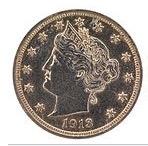
Is there anything you'd rather do less than read an article about nickel? Didn't think so. Seriously boring. So much so that I've taken the liberty of creating a new category in the periodic table of the elements - Boring Metals.
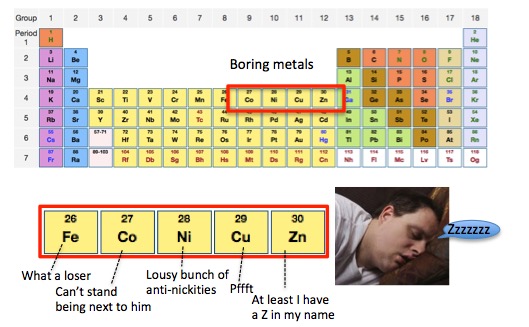
But if you keep reading you'll see that nickel is anything but boring. Depending on the form of the metal it has some pretty crazy properties. One form of it bursts into flames when exposed to air and another form is a deadly poison and also bursts into flames when exposed to air. It is also considered to be a human carcinogen and is responsible for a type of eczema. And the nickel is the only US coin minted today that is named after the metal from which is it made. But that's inaccurate; there isn't much nickel in a nickel. So, let's continue so you get your five-cents worth.
DIFFERENT FORMS OF NICKEL
Minerals
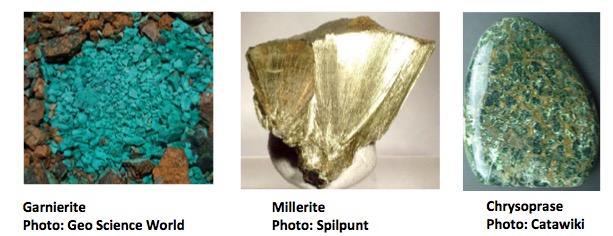
Nickel is both interesting and beautiful. Above are three nickel-containing minerals. Garnierite (top, left) is a mixture of nickel, magnesium, silicon, and oxygen. But according to the Commission on New Minerals, Nomenclature and Classification (I bet their annual convention is a real blast) garnierite is not a valid name for ... garnierite. It has also been referred to as serpentine, stevensite and sepiolite. Like anyone cares?
The specimen in the middle is millerite, which is mostly nickel sulfide. Millerite is not only beautiful but is also historically important. According to Minerals.net, it was "named in honor of William Hallowes Miller (1801 – 1880), a prominent Welsh mineralogist responsible for laying the foundations of modern crystallography. The Miller indices relating to crystallography are named after him."
Chrysoprase is mostly quartz but contains enough nickel to give it its color. Believe it or not, the website Healing With Crystals offers some useful scientific information!
Chrysoprase is a silicon dioxide mineral that that belongs to the chalcedony group of quartz crystals. The presence of nickel in the mineral has altered the normal colourless quartz mineral to a beautiful green translucent stone.
OK, maybe not.
Chrysoprase stimulates detoxification and elimination of waste from the body...will stimulate fertility in women, particularly if infections such as STD's have led to infertility. If your hormones are out of balance and you are having difficulty conceiving, chrysoprase will assist...
Powdered
There are two forms of nickel that are used by chemists that need to be handled with caution. One is called Raney nickel, a very fine powder, which is very effective for hydrogenation (adding hydrogen) reactions. Raney nickel is very useful to chemists.
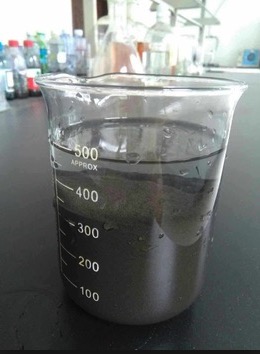
Raney nickel in water. Photo: Alibaba
But you'd better keep it wet. Raney nickel has a very large surface area and it retains some of the hydrogen that is generated when it is made. So, there are very few chemists who have used the stuff that haven't run into this...
https://www.youtube.com/watch?v=R5JjG8ASBmc
Organonickel
Another form of nickel is far worse - nickel tetracarbonyl. It consists of nickel, which is carcinogenic, (1) bound to four molecules of carbon monoxide (toxic). And also happens to burst into flames when it's in the mood. And it's always in the mood.
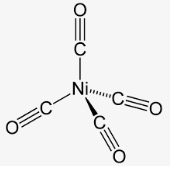
The chemical structure of nickel tetracarbonyl. No thanks. Photo: Wikipedia.
Chemistry blogger Derek Lowe, a wickedly good writer even on a bad day, absolutely outdoes himself in his always-popular "Things I won't work with" blog (emphasis mine):
Nickel carbonyl is a liquid, but it can barely restrain itself from being a gas. It boils at 43 C, so it has a pretty substantial vapor pressure, and that’s a real problem. Said vapor, as you’d imagine, is rather weighty. It’s not one of your wafting-away-on-the-summer-zephyr sort of vapors; it’s more like a sort of ghostly molasses...
Even if the vapor doesn’t get the chance to wander around poisoning you, it can amuse itself right in your fume hood. If it rolls across a hot surface, of which there are no shortage in most working hoods, then it can explode, leaving behind a vile haze of carcinogenic nickle soot. [how great is this??]...
and just in case you haven't gotten the message yet...
An exploding toxin with a high vapor pressure – I just don’t know what else you could ask for in a laboratory reagent. No doubt it does many interesting and useful reactions. They can save ’em for me, because I’m not that desperate yet.
OTHER COOL STUFF ABOUT NICKEL
- Nickels are not nickel. They are 75% copper and 25% nickel. But it will have to do. Neither "noppers" or "cickels" roll off the tongue.
- Skin allergies to nickel are common, resulting in atopic dermatitis (eczema). Since nickel is often found in jewelry some people cannot wear any.
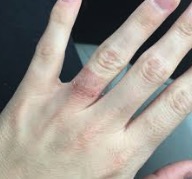
Atopic dermatitis caused by nickel. In case you need an excuse to take off your wedding ring. Wink. Photo: Calla Gold
- The first nickel coin, which was minted in 1865 was a three-cent piece. At that time coins worth five-cents were called half-dimes. Half-dimes, which were made of silver were profoundly annoying because they were small and easy to lose. But these were put to shame by the silver three-cent piece (1851-1872) - the smallest US coin ever minted, which was created in response to the new three-cent stamp. Damn things were even easier to lose (2).
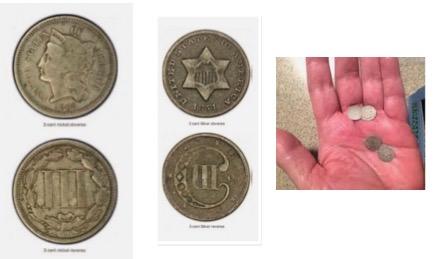
(Left) The first nickel was worth three-cents. (Right) So was the silver three-cent piece. Those bad boys were seriously small. Photos: Tony Lawrence's Coins & Stuff
- And while we are on the subject of numismatics, the first five-cent piece to be called a nickel was the Barber Liberty Head nickel (3). It was minted from 1883 until 1912 during when it was replaced by the Buffalo nickel.
- But then this happened:
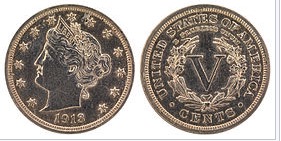
A 1913 Liberty Head nickel - one of five in the world. Photo: Wikipedia.
In 1920 it was discovered that in 1913 five of these coins were minted, either by mistake, or intentionally, and they ended up in the hands of one mint employee. A 1913 Liberty Head nickel, one of the rarest coins in the world, recently sold for $4.5 million, the equivalent of 90,000,000 nickels.
- Finally, if you were ever told "don't take a wooden nickel," it would be wise to disregard this advice. There really is such a thing. In 1931, when banks were failing all over the US, some offered depression scrip - a substitute for money, which was rare at the time. The Citizens Bank of Tenino became famous for issuing a certificate "worth" five-cents. These were printed on very thin pieces of wood. Original wood depression scrip is rare and valuable.
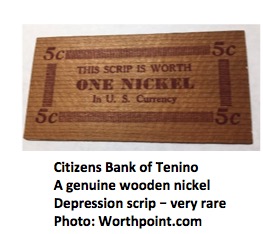
NOTES:
(1) Nickel is listed as a carcinogen on California's Proposition 65 list. Metallic nickel is classified by IARC as a Class 2B (possibly carcinogenic to humans).
(2) Owned one once. And lost it. Duh.
(3) Nickels, dimes, quarters, and half-dollars minted between 1892 and 1916 are called Barber Liberty Head Coins, after the chief designer of the US Mint, Chief Engraver Charles E. Barber



